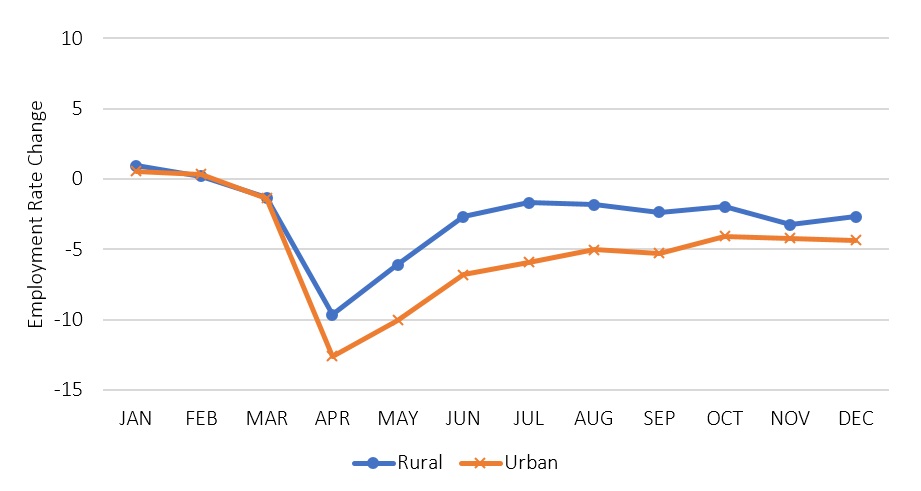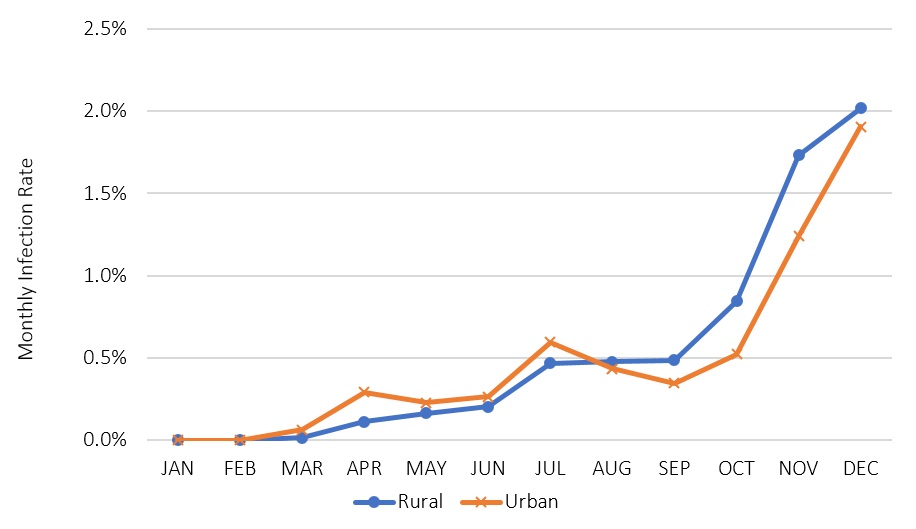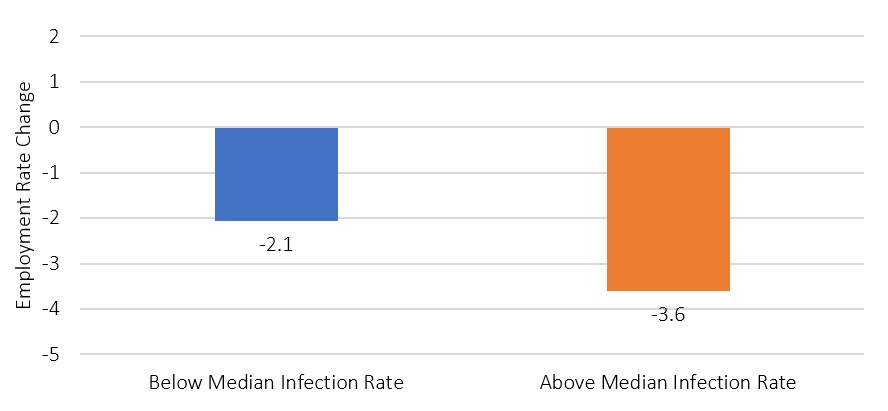

Note: Rural areas are defined to include all nonmetropolitan
counties; urban areas include all metropolitan counties.
Source: Authors' estimates based on the U.S. Current
Population Survey.

Note: Rural areas are defined to include all nonmetropolitan
counties; urban areas include all metropolitan counties.
Source: Authors' estimates based on the USAFacts (2020).

Source: Authors' estimates based on the U.S. Current
Population Survey.
COVID-19 disrupted economic activity throughout the United States in 2020. The employment losses were less severe in rural areas than in urban areas (Cho, Lee, and Winters, 2020a,b). Both rural and urban areas experienced partial employment recovery in subsequent months but were still significantly worse off through December 2020 than before the pandemic (Figure 1).
The larger early employment losses in urban areas than rural areas were driven by their higher initial COVID-19 infection rates (Cho, Lee, and Winters, 2020a). The pandemic recession was driven by individuals and firms altering their behavior to mitigate their own exposure to the virus (Chetty et al., 2020). The fear and uncertainty created by the virus is the primary cause of employment losses during the pandemic (Goolsbee and Syverson, 2020). Rural areas had lower initial infection rates and less motivation for people and businesses to alter their economic behavior (Figure 2). However, the lower COVID-19 infection rates in rural areas did not last. Rural areas surpassed urban areas in new infection rates in August 2020 and had persistently higher rates through December 2020. Further, both rural and urban areas experienced rapid increases in infection rates during the last three months of 2020.
The rapid rise in infections during the latter months of 2020 stalled the economic recovery. Rural employment recovered significantly during the first few months after April 2020 and had almost fully recovered by July 2020. The recovery was partially driven by adaptations such as working from home, wearing personal protective equipment, and dining outdoors at restaurants. Additionally, the initial plunge in employment was driven by uncertainty about the risks involved in various activities. As knowledge about the virus improved, some people felt more confident in resuming economic activity, which helped facilitate the initial economic recovery. However, the resumption of some economic activities may have contributed to rising infection rates. Rising infection rates caused a resurgence in rural job losses and prevented further economic recovery. Year-over-year employment changes for rural areas in November 2020 were the worst they had been since May 2020, and December 2020 saw minimal recovery.
The local industrial structure also somewhat affected employment outcomes during the pandemic. For example, leisure and hospitality was very hard hit while agricultural employment was relatively stable. Leisure and hospitality employment is more concentrated in urban areas, and agriculture is concentrated in rural areas. However, industrial structure is not the primary factor explaining differential rural and urban employment impacts (Cho, Lee, and Winters, 2020a). Differences in individual characteristics like age, education, gender, and race are also not the primary factor. State policies mandating business closures are also not a primary cause (Goolsbee and Syverson, 2020).
There are also differing employment impacts across rural areas. For November–December 2020, rural areas with COVID-19 infection rates above the median had larger year-over-year employment rate decreases than those with infection rates below the median (Figure 3). Thus, rural areas with higher COVID-19 infection rates have worse employment outcomes. Additionally, the oil and gas industry and rural areas heavily reliant on the industry have been especially adversely affected by reduced demand for travel during the pandemic. There is also anecdotal evidence that some high amenity rural areas have done relatively well, especially during the summer of 2020, as people sought vacations in remote areas.
The evidence suggests that rural employment will not fully recover until the pandemic is contained. Vaccinations will hopefully play an important role in ending the pandemic and restoring employment to prepandemic levels. However, some individuals are reluctant to receive the vaccine, and this appears especially relevant for some rural areas due to less trust of government and greater individualism (Fisher et al. 2020; Kirzinger, Muñana, and Brodie 2021; Nguyen et al. 2021). Low vaccination rates may cause the virus to drag on instead of ending quickly.
Even after much of the U.S. population is vaccinated, lower vaccination rates around the world may continue to impede international travel and tourism and hinder oil industry employment recovery. Conversely, many businesses and workers with favorable experiences with remote work during the pandemic may view it as a good option going forward, which may increase employment opportunities for rural residents and increase the desirability of rural residence for more workers in a variety of industries. Of course, high-speed Internet is a critical input in working from home, and many rural areas still have limited access.
We also conducted additional analysis with results reported in Cho, Lee, and Winters (2020a). There, we document that there were large differences in pandemic employment impacts by metropolitan area population size. Specifically, larger metropolitan areas suffered worse employment reductions than smaller metropolitan areas during the early months of the pandemic and large differences persisted in subsequent months.
In Cho, Lee, and Winters (2020a), we also use statistical analysis to examine the potential role of various factors in explaining differences in employment losses across areas. We find that local COVID-19 infection rates are a major factor explaining employment differences across areas. Areas with higher infection rates experienced larger employment reductions. The higher early infection rates in urban areas also had persistent adverse effects on employment. This may suggest that some individuals and businesses in urban areas viewed COVID-19 as a more serious risk than those in rural areas and altered their behavior more in urban areas than in rural areas, perhaps even after rural infection rates exceeded urban infection rates.
The local industrial structure also affects pandemic employment impacts across areas. The leisure and hospitality industry experienced especially severe employment reductions. Areas heavily concentrated in leisure and hospitality were very hard hit. Urban areas had somewhat higher leisure and hospitality employment concentrations than rural areas, so this explains some of the differing overall employment impacts between rural and urban areas, especially during the early months of the pandemic. Additionally, the agriculture sector was relatively stable during the pandemic compared to other industries, and rural areas have greater employment concentration in agriculture, which has overall helped stabilize rural employment. However, oil, gas, and coal industry employment is also more concentrated in rural areas and was hard hit during the pandemic. Industry mix is overall not the predominant factor explaining differing employment impacts across rural and urban areas (Cho, Lee, and Winters 2020a).
We present evidence in Cho, Lee, and Winters (2020a) that state policy responses such as mandated business closures are not a predominant factor driving employment decreases during the pandemic. This result is also corroborated by other researchers (Chetty et al., 2020; Goolsbee and Syverson, 2020).
Individual characteristics such as age, education, gender, race, and ethnicity are important factors explaining an individual’s likelihood of employment. However, we find in Cho, Lee, and Winters (2020a) that individual characteristics on the whole explain relatively little of the differing pandemic employment impacts across areas. For example, urban areas have higher percentages of college graduates and higher percentages of racial minorities than rural areas. College graduates have smaller reductions in employment rates than nongraduates, but racial minorities have larger employment rate reductions than whites. On the whole, these and other individual differences between rural and urban areas have largely offsetting effects on employment impacts. Thus, the differences in job losses between rural and urban areas are not driven by differences in individual characteristics.
Our employment data are based on individual-level records from the U.S. Current Population Survey (CPS). The CPS is the data source the Bureau of Labor Statistics uses to compute the official unemployment rate and labor force participation rate for the United States. The pandemic increased unemployment, reduced labor force participation, and increased the prevalence of persons with jobs being temporarily absent from work (Cho, Lee, and Winters, 2020a,b). Looking only at the unemployment rate would understate employment losses because it does not incorporate labor force withdrawal and temporary employment absences. To incorporate all these adverse effects into a single measure of employment changes, we focus on the percentage of individuals (ages 16 and older) who are employed and at work as our employment rate measure; persons who are working remotely from home are included as employed and at work. To account for seasonality, we focus on year-over-year changes by calendar month. For example, we compare the employment rate in April 2020 to April 2019 and December 2020 to December 2019.
We define metropolitan areas as urban and nonmetropolitan areas as rural. The CPS reports whether individuals live in a metropolitan area or a nonmetropolitan area. We are unable to identify individuals’ place of work or whether they commute between rural and urban areas. We also cannot identify the specific county for rural residents; the CPS only reports an individual’s state and that they live in a nonmetropolitan area.
We obtained COVID-19 infection data from USAFacts (2020). We compute the total number of infections in rural and urban areas by calendar month and divide by their population to compute the percentage of COVID-19 confirmed infections by month.
We examined differences in employment rate decreases across rural areas by COVID-19 infection rates in November and December 2020. Specifically, we classified rural areas into those above and below the median infection rate for rural areas in November–December. We then computed average employment rate decreases for November and December 2020 for those above and below the median infection rate. We use two months instead of one to increase sample sizes and smooth out sampling variation.
The COVID-19 pandemic caused major job losses in Spring 2020. Rural employment largely recovered during the summer but subsequently plateaued and even regressed as rural infection rates climbed during the latter months of 2020. By December 2020 the rural employment rate was still significantly below the previous year. Rural employment losses are higher in areas with higher COVID-19 infection rates. Controlling the virus is critical for restoring employment to prepandemic levels.
Cajner, T., L.D. Crane, R.A. Decker, J. Grigsby, A. Hamins-Puertolas, E. Hurst, C. Kurz, and A. Yildirmaz. 2020. “The US Labor Market During the Beginning of the Pandemic Recession.” NBER Working Paper 27159.
Chetty, R., J.N. Friedman, N. Hendren, and M. Stepner. 2020. “How Did COVID-19 and Stabilization Policies Affect Spending and Employment? A New Real-Time Economic Tracker Based on Private Sector Data.” NBER Working Paper 27431.
Cho, S.J., J.Y. Lee, and J.V. Winters. 2020a. “Employment Impacts of the COVID-19 Pandemic across Metropolitan Status and Size.” Working paper, Ames, IA: Iowa State University Department of Economics.
Cho, S.J., J.Y. Lee, and J.V. Winters. 2020b. “Rural Areas and Middle America See Smaller Employment Losses from COVID-19.” Agricultural Policy Review 2020(2): 1.
Coibion, O., Y. Gorodnichenko, and M. Weber. 2020. “Labor Markets during the COVID-19 Crisis: A Preliminary View.” NBER Working Paper 27017.
Fisher, K.A., S.J. Bloomstone, J. Walder, S. Crawford, H. Fouayzi, and K.M. Mazor. 2020. “Attitudes toward a Potential SARS-CoV-2 Vaccine: A Survey of US Adults.” Annals of Internal Medicine 173(12): 964–973.
Goolsbee, A., and C. Syverson. 2020. “Fear, Lockdown, and Diversion: Comparing Drivers of Pandemic Economic Decline 2020.” Journal of Public Economics 193: 104311.
Kirzinger, A., C. Muñana, and M. Brodie. 2021, January 7. “Vaccine Hesitancy in Rural America.” Kaiser Family Foundation. Available online: https://www.kff.org/coronavirus-covid-19/poll-finding/vaccine-hesitancy-in-rural-america./
Mongey, S., L. Pilossoph, and A. Weinberg. 2020. “Which Workers Bear the Burden of Social Distancing Policies?” NBER Working Paper 27085.
Mueller, J.T., K. McConnell, P.B. Burow, K. Pofahl, A.A. Merdjanoff, and J. Farrell. 2020. “Impacts of the COVID-19 Pandemic on Rural America.” Proceedings of the National Academy of Sciences 118(1): 2019378118.
Nguyen, K.H., A. Srivastav, H. Razzaghi, W. Williams, M.C. Lindley, C. Jorgensen, N. Abad, and J.A. Singleton. 2021. “COVID-19 Vaccination Intent, Perceptions, and Reasons for Not Vaccinating among Groups Prioritized for Early Vaccination—United States, September and December 2020.” Morbidity and Mortality Weekly Report 70(6): 217–222.
Peña-Lévano, L., S. Burney, and C. Adams. 2020. “Labor Disruptions Caused by COVID-19 in the US Agriculture and Nonfarm Industries.” Choices 35(3).
USAFacts, 2020. Coronavirus Locations: COVID-19 Map by County and State. Available online: https://usafacts.org/visualizations/coronavirus-covid-19-spread-map/ [Accessed January 8, 2021].